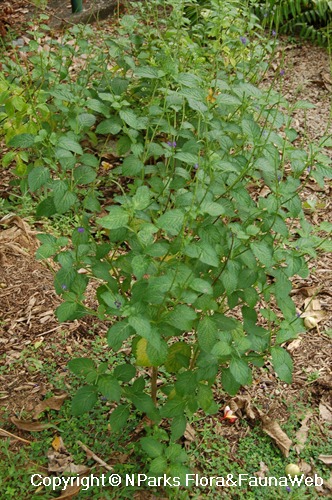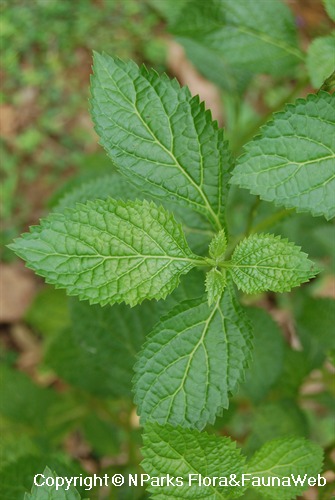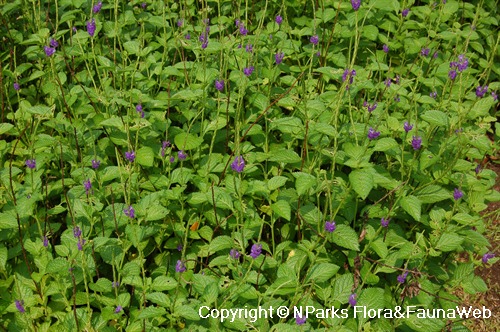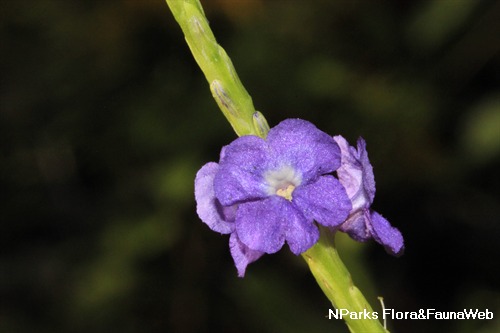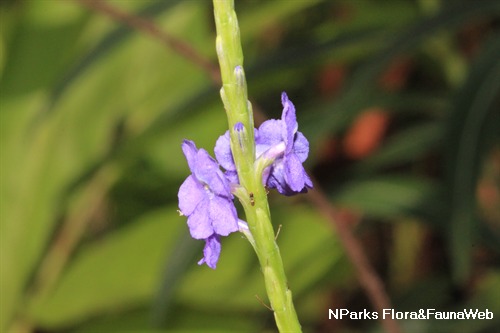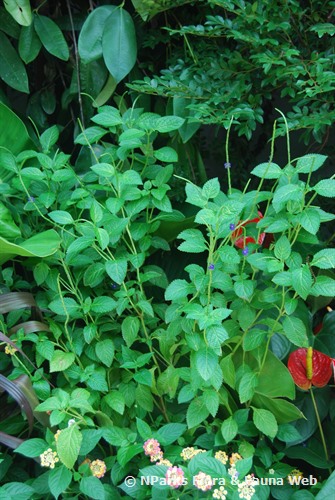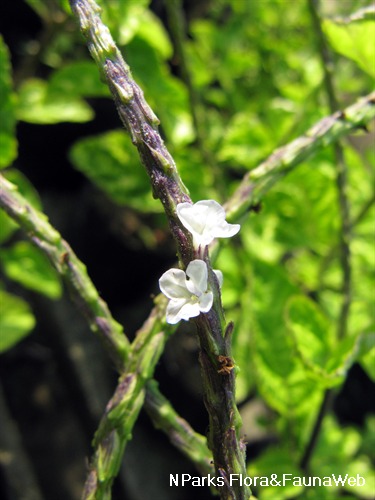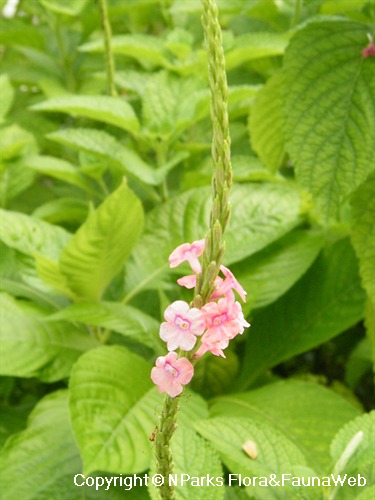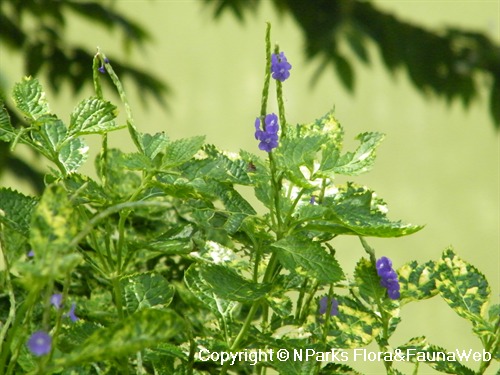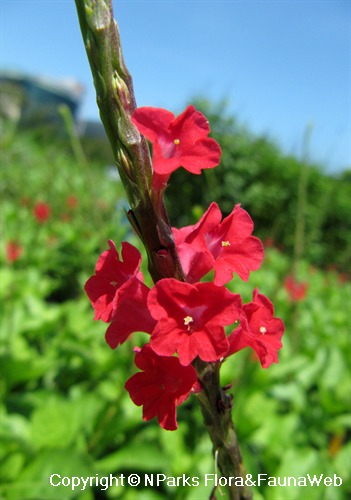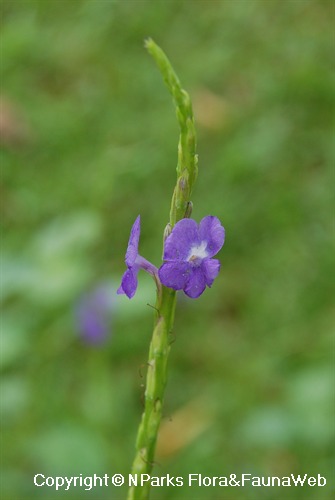
Back
Stachytarpheta jamaicensis (L.) Vahl
| Family Name: | Verbenaceae |
| Synonyms: | Stachytarpheta indica auct. non (L.) Vahl |
| Common Name: | Purple Snakeweed, Brazilian Tea, Rooter Comb, Verbena Cimarrona, Gervao, Blue Porter Weed |
Name
Classifications and Characteristics
| Plant Division | Angiosperms (Flowering Seed Plants) (Dicotyledon) |
|---|---|
| Plant Growth Form | Shrub |
| Lifespan (in Singapore) | Perennial |
| Mode of Nutrition | Autotrophic |
| Plant Shape | Rounded |
| Maximum Height | 1 m |
Biogeography
| Native Distribution | Africa |
|---|---|
| Native Habitat | Terrestrial (Coastal Forest, Disturbed Area / Open Ground) |
| Preferred Climate Zone | Tropical |
| Local Conservation Status | Non-native (Spontaneous (Naturalised)) |
Description and Ethnobotany
| Growth Form | Woody erect shrub with long prominent spike inflorescences. This species might be a hybrid between Stachytarpheta jamaicensis and Stachytarpheta angustifolia. Habitat: Found in tropical environments with a distinct dry season. Occurs along seashores and roadsides, as well as in disturbed areas, coconut plantations and mango groves. In Africa and Southeast Asia, this species is considered a weed in rice fields and pastures. |
|---|---|
| Foliage | Opposite leaves are elliptic to ovate with dentate leaf margin (4 - 11 cm long). |
| Stems | Woody stem has tan bark with linear-shaped lenticels. |
| Flowers | Salverform, blue to purple flowers have a white throat and 5 lobes (1.3 cm wide). They are arranged on a 15 - 40 cm long terminal spike inflorescence (an inflorescence at the stem tip which has stalkless flowers held along one main axis). Only about 2 - 3 flowers are open at a time on the spike, lasting for one day and replaced by a new set the next day. The inflorescence blooms in this manner for several weeks. |
| Fruit | Dry, indehiscent fruit is known as a nutlet, a one-seeded small nutlike fruit. It is formed by the fragmentation of a multi-sectioned fruit into single-seeded pieces. |
| Taxonomy | Previous name of Stachytarpheta indica auct. non (L.) Vahl misused in Singapore. Current name of Stachytarpheta jamaicensis (L.) Vahl is applicable to naturalised plants in Singapore. |
| Cultivation | Plant in well-drained, fertile soil enriched with compost. To prevent excessive establishment of new seedlings, remove spent flowers before they set seed. |
| Etymology | The genus 'Stachytarpheta' comes from the Greek words for spike ("stachys") and thick ("tarphys"). It refers to the spike inflorescence found in many species of this genus. |
| Ethnobotanical Uses | Food (Herb or Spice) Others: In Nigeria, Snakeweed is traditionally used to treat diabetes and fever. In West Africa, the juice from the plant is used to treat cataract and sores on children’s ears. In Brazil, fresh leaf is crushed and applied on ulcers. Leaf extracts were shown to protect liver cells from a toxic chemical (Joshi et al 2010).The level of protection was comparable to a standard hepatoprotective drug called Liv-52. |
Landscaping Features
| Landscaping | This species is planted as an ornamental shrub for its beautiful blue to purple flowers. It is ideal for butterfly gardens as a nectar plant. Place them in the back to avoid obscuring smaller species. Consider planting it alongside Stachytarpheta indica (variegated) which has green leaves with yellow spots. The variegated and non-variegated forms will blend nicely in terms of leaf shape, while providing a pleasing contrast in colours. |
|---|---|
| Desirable Plant Features | Ornamental Flowers |
| Landscape Uses | Flowerbed / Border, Hedge / Screening, Coastal |
| Thematic Landscaping | Butterfly Garden |
| Usage Hazard - Cons | Invasive / Potentially Invasive |
Fauna, Pollination and Dispersal
| Fauna Pollination Dispersal Associated Fauna | Butterfly-Attracting |
|---|---|
| Pollination Method(s) | Biotic (Fauna) (Insects (Butterfly, Moth)) |
| Seed or Spore Dispersal | Abiotic |
Plant Care and Propagation
| Light Preference | Semi-Shade, Full Sun |
|---|---|
| Water Preference | Moderate Water |
| Plant Growth Rate | Moderate |
| Rootzone Tolerance | Fertile Loamy Soils, Well-Drained Soils |
| Propagation Method | Seed, Stem Cutting |
| Propagation Method Remarks | Propagate by seed or softwood cuttings. To collect seeds for propagation, allow the seedhead to dry on the plant before harvesting the seeds. |
Foliar
| Mature Foliage Colour(s) | Green |
|---|---|
| Foliar Type | Simple / Unifoliate |
| Foliar Arrangement Along Stem | Opposite |
| Foliar Shape(s) | Non-Palm Foliage (Ovate, Elliptical) |
| Foliar Venation | Pinnate / Net |
| Foliar Margin | Dentate |
| Foliar Apex - Tip | Acute |
| Foliar Base | Acute |
| Typical Foliar Area | Mesophyll ( 45cm2 - 182.25 cm2 ) |
| Leaf Area Index (LAI) for Green Plot Ratio | 4.5 (Shrub & Groundcover - Dicot) |
Non - Foliar and Storage
| Bark Colour(s) | tan |
|---|---|
| Mature Bark Texture | Lenticellate |
| Stem Type & Modification | Woody |
| Root Type | Underground (Tap Root) |
Floral (Angiosperm)
| Flower & Plant Sexuality | Bisexual Flowers |
| Flower Colour(s) | Blue, Purple |
|---|---|
| Flower Symmetry | Radial |
| Individual Flower Shape | Salverform |
| Inflorescence Type | Spike |
| Flowering Opening Time | Daytime |
| Flower Lifespan on Plant | 1 Day |
Fruit, Seed and Spore
| Fruit Classification | Simple Fruit |
|---|---|
| Fruit Type | Indehiscent Dry Fruit , Nut / Nutlet |
Image Repository
Others
| Master ID | 1182 |
|---|---|
| Species ID | 2475 |
| Flora Disclaimer | The information in this website has been compiled from reliable sources, such as reference works on medicinal plants. It is not a substitute for medical advice or treatment and NParks does not purport to provide any medical advice. Readers should always consult his/her physician before using or consuming a plant for medicinal purposes. |

